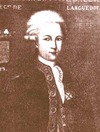CRAWFORD, ALEXANDER, Baptist preacher and author; b. 1786 in Argyllshire, Scotland; d. 13 May 1828 in Tryon, P.E.I.
Although born in Argyllshire, Alexander Crawford spent his early years on the Isle of Arran, where he became exposed to a breakaway Presbyterian sect led by Robert and James Alexander Haldane, which had both pietistic and revivalistic tendencies. Crawford subsequently attended an academy in Edinburgh organized by the Haldane brothers, and shortly thereafter became convinced of the scriptural unsoundness of infant baptism. He joined the tiny group in Scotland led by James Alexander Haldane, who in 1808 took his Edinburgh congregation into the Baptist fold. In 1809 Crawford married Jane MacLaren of Breadalbane and the couple emigrated to Nova Scotia, where he attempted to preach and exhort.
Nova Scotia was fertile territory both for itinerant preaching and for anti-paedobaptist principles, but the peculiar tenets of the Scotch Baptists led to much opposition to Crawford, especially among the clergy. Because of their Presbyterian origins, the Scotch Baptists tended to be extremely suspicious of sudden crisis conversions, which were at the heart of the Nova Scotia New Light-Baptist experience, and they were also exclusivist, opposing marriage with unbelievers and barring from fellowship any who married spouses not adhering to their tenets. Moreover, the Scotch Baptists refused to regard the Lord’s Supper as a church ordinance, but instead permitted any small group of laymen to celebrate communion among themselves.
In 1811 Crawford came to Prince Edward Island, where there was a large Scottish population and few competing clergymen of any denomination. He was probably encouraged to migrate to the Island by John Scott, another Haldanite who had come in 1806 and was a lay exhorter there for many years. Crawford was much better educated than Scott and was both a compelling preacher (although some said overbearing in manner) and an energetic organizer. He may have taught briefly at Charlottetown, but soon spent his full efforts on religious activity. His first successes were on Lot 48, where he immersed eight believers. A great storm a few days later was blamed by Islanders on his temerity in “plunging” people rather than sprinkling them. Although he organized a church in the Three Rivers (Georgetown) region in 1812, he left the Island briefly for Nova Scotia and returned permanently only in 1814, settling a year later at East Point through the support of two local people, both formally adherents of the Church of Scotland. Crawford remained based at East Point until his death; he organized a church but never became ordained, probably because he was unable to assemble an ordaining council. He did not associate with the Maritime Baptists, and for many years after his death the peculiar beliefs of the Island’s Scotch Baptists remained a stumbling–block to union between the two groups.
James Douglas Haszard* of Charlottetown in 1827 printed a book written by Crawford the year before entitled Believer immersion, as opposed to unbeliever sprinkling, the first substantial religious publication on the Island or by an Island clergyman. It contained two lengthy doctrinal essays on the Abrahamic Covenant, and three polemic letters supporting the Baptist arguments of William Elder* of Nova Scotia, who had engaged in a lengthy controversy in print with Duncan Ross and James Munroe, both Presbyterian paedobaptists. In this work Crawford did not pursue the peculiarities of his brand of Baptist belief, but concentrated instead on the larger question of the scriptural justification for believer’s baptism. He refused to accept the typological arguments which were used to find support for infant baptism in the Old Testament, particularly the commitment by God to the “seed” of Abraham. For Crawford, circumcision and baptism were quite distinct: “Circumcision is a cutting off the extreme point of the generating member. Baptism is the immersion of the body in water. They represent different things.” Like all Baptists, he defied his opponents to find New Testament justification for the baptism of infants, and suggested that the practice entitled them to be regarded as church members although they were clearly too young to assume the responsibilities of membership. He accused the Presbyterians of a concept of “hereditary christianity” which was “ anticalvinist in disguise.”
Believer immersion demonstrated Crawford’s intellectual capabilities and may in part have been intended as a preliminary gesture of fellowship with Baptists off the Island. Unfortunately, he died soon after its publication. He was survived by his wife and eight children.
Alexander Crawford is the author of Believer immersion, as opposed to unbeliever sprinkling; in two essays: first on the Abrahamic covenant, second on Christian baptism; to which are added three letters to Mr. Ross of Pictou, containing strictures on his first letter to Mr. Elder of Annapolis (Charlottetown, 1827).
Atlantic Baptist Hist. Coll., Acadia Univ. (Wolfville, N.S.), [W. H. Warren], “A century of Baptist history on Prince Edward Island.” PAPEI, Acc. 3209/33 (photocopy). P.E.I. Museum and Heritage Foundation (Charlottetown), File information concerning Alexander Crawford.
© 1987–2024 University of Toronto/Université Laval
Cite This Article
J. M. Bumsted, “CRAWFORD, ALEXANDER,” in Dictionary of Canadian Biography, vol. 6, University of Toronto/Université Laval, 2003–, accessed April 26, 2024, http://www.biographi.ca/en/bio/crawford_alexander_6E.html.
The citation above shows the format for footnotes and endnotes according to the Chicago manual of style (16th edition). Information to be used in other citation formats:
| Permalink: | http://www.biographi.ca/en/bio/crawford_alexander_6E.html |
| Author of Article: | J. M. Bumsted |
| Title of Article: | CRAWFORD, ALEXANDER |
| Publication Name: | Dictionary of Canadian Biography, vol. 6 |
| Publisher: | University of Toronto/Université Laval |
| Year of publication: | 1987 |
| Year of revision: | 1987 |
| Access Date: | April 26, 2024 |





